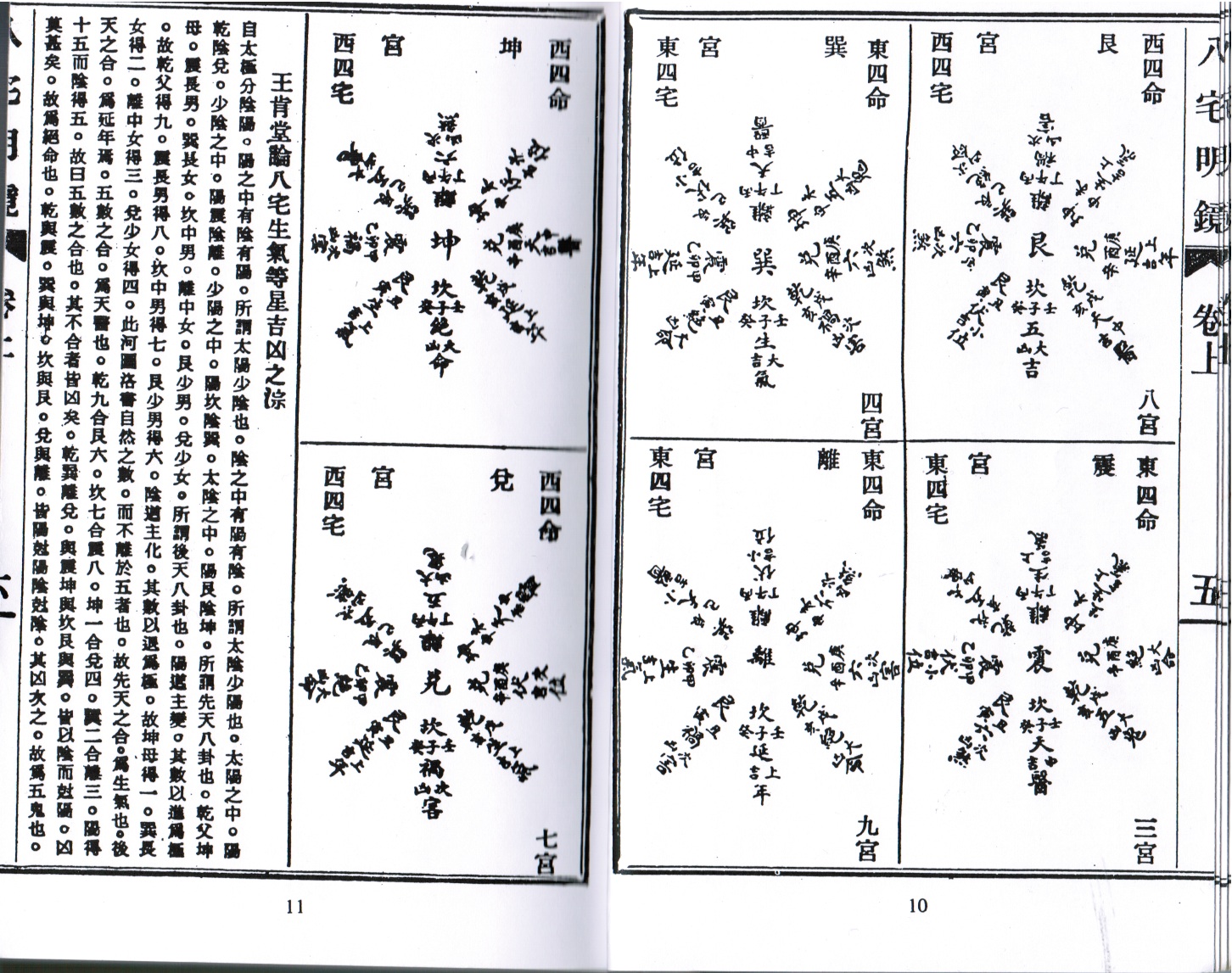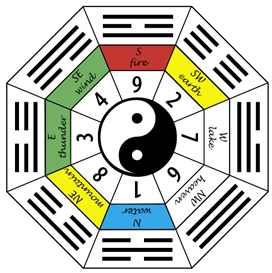Taken from “A Guide to Reading the Bazhai Ming Jing (The Bright Mirror of Bazhai)”, written by Jiang Jue-Ming, 1997. Translated by Howard Choy.
 Chinese Kanyu Dili (Feng Shui) was mainly concerned with the study of Yin and Yang Houses. The Yin Houses (graves) emphasised on predicting the fortune and decline of a deceased’s family and the Yang Houses (residence) emphasised on analysing the fortune and decline of the Living. Kanyu is intimately related to our lives. It is one of the five important inventions by the Chinese.
Chinese Kanyu Dili (Feng Shui) was mainly concerned with the study of Yin and Yang Houses. The Yin Houses (graves) emphasised on predicting the fortune and decline of a deceased’s family and the Yang Houses (residence) emphasised on analysing the fortune and decline of the Living. Kanyu is intimately related to our lives. It is one of the five important inventions by the Chinese.
Kanyu of Yin and Yang Houses has produced many schools after thousands of years of development, and the Bazhai School is one of the more important schools. It has its beginnings in the Tang Dynasty (618-907) and became popular in the Song Dynasty (960-1279).
Three representative books on Bazhai were mentioned in the “History of the Song Dynasty”; they were: -
- “Huang-di Bazhai Jing -- The Yellow Emperor’s Classic of Bazhai.
- “Huai-nan-wang Jianji Bazhai Jing” -- The Classic of Bazhai According to the King of Southern Huai (Jiangsu).
- “Huang-shi-gong Bazhai” -- The Bazhai of Old Man Yellow Stone.
Since the word Bazhai was mentioned in all 3 classics, the ‘Bazhai School’ was known from then on.
After the Song Dynasty, the school continued to prosper and became quite popular. During the Ming (1368-1644) and the Qing (1644-1911) Dynasties, many more books on Bazhai appeared.
They included:
- “Yang Zhai Cuo-Yao” -- Yang Houses Abstract.
- “Yang-zhai Da-Cheng” -- The Great Achievements of Yang Houses
- “Jin-guang-Dou-Lin Jing” -- Classic of the Dipper Casting its Golden Light
- “Yang-Zhai Shi-Shu” -- The Ten Books of Yang Houses
- “Yang-Zhai Ji-Cheng” -- The Complete Anthology of Yang Houses
- “Yang-Zhai San-Yao” -- The Three Requirements of Yang Houses
- “Bazhai Ming-Jing” -- The Bright Mirror of Eight Houses
- “Yang-Zhai Ai-Yiang Pian” -- A Companion for Yang Houses
Up until now, Bazhai is still considered by many overseas Chinese as an authentic school of Kanyu.
What is Bazhai
Bazhai (or Eight Houses) is in reality the eight directions, which are related to the Nine Stars (of the Big Dipper), the Nine Palaces (of the Luoshu Diagram) and the Bagua (the Eight Trigrams). It is part of Yang House Kanyu.
The directions and the auspiciousness of the East Four and the West Four life are related to the Bagua, which can be traced back to popularity of the Yi Pictures Study in the Song Dynasty.
 The diagrams of the Hetu, the Luoshu, the Xiantian (Earlier Heaven) and Huotian (Later Heaven) Bagua were passed down by Huashan Haoist Chen Tuan during the Song Dynasty. Later on, they were transmitted through Shao Yong in his book “Huang-ji Jing-shi” (The Empirical YiJing), Zhou Din-Yi’s “Taiji Tu Shuo” (An Explanation of the Taiji Pictures) and Zhu Xi’s “Zhou-Yi Ben-Yi” (The Original Meaning of Zhou-Yi). Nowadays, the Yijing Bagua is a household name.
The diagrams of the Hetu, the Luoshu, the Xiantian (Earlier Heaven) and Huotian (Later Heaven) Bagua were passed down by Huashan Haoist Chen Tuan during the Song Dynasty. Later on, they were transmitted through Shao Yong in his book “Huang-ji Jing-shi” (The Empirical YiJing), Zhou Din-Yi’s “Taiji Tu Shuo” (An Explanation of the Taiji Pictures) and Zhu Xi’s “Zhou-Yi Ben-Yi” (The Original Meaning of Zhou-Yi). Nowadays, the Yijing Bagua is a household name.
Zhu Xi’s “Zhou-Yi Ben-Yi” has the Fuzi and the Wen Wang Bagua arrangements in his classic. The Fuzi Bagua (Earlier Heaven Bagua) is made up of the Taiji dividing into the Yin Yang polarity (Lian Yi), which further divided into the Sixiang of Tai Yang, Xiao Yang, Tai Yin and Xiao Yin.
The Yang House (Bazhai) method grouped the four gua belonging to Tai Yang and Tai Yin into the West Four Life (Xi-Si-Ming) and the four gua belonging to the Xiao Yang and Xiao Yin to the East Four Life (Dong-Si-Ming, see diagram at end of article). It then used the Wen Wang (Later Heaven) Bagua to set the directions for the East Four and the West Four Life. By comparing them to the Nine Stars, they assigned Auspiciousness and Harmfulness to the orientations.
Bazhai Feng Shui is also called Yi Gua (Yijing Trigram) Feng Shui. These days, it is one of the more popular Liqi (compass) schools. Some people think Bazhai Feng Shui is too simple, since, in principle, it divides the house and people into two categories. If the house and people fit in with each other, then it is auspicious, if they don’t then it is harmful. This is the most basic dictum. However, if we study the subject deeply, we will find Bazhai Kanyu has more depth than first realised. Of course, establishing the auspiciousness and the harmfulness of a situation are the main characteristics of Bazhai Kanyu.
“Bazhai Ming Jing” (The Bright Mirror of Eight Houses) was passed down by Daoist Monk Ruo-Guan Daoren. It is a representative work of knowledge transmitted by Yang Jun-Song of the Tang Dynasty. Although Ruo-Guan Daoren has no real name, and we don’t know his age or birth details, we know his book was first published by “Xu Jiang Diao Sou” (The Old Fisherman of Xu River) Gu Wa-lu in the 55th year of the Reign of Emperor Qian Long (1791). In the last 300 years, it has become a must-read book for those who want to study Kanyu seriously.
{jshop-prod-ins:4}


